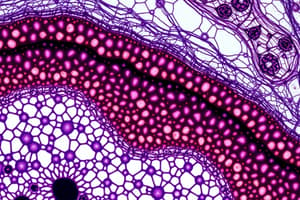Podcast
Questions and Answers
What is the main difference between transmission electron microscopy (TEM) and scanning electron microscopy (SEM)?
What is the main difference between transmission electron microscopy (TEM) and scanning electron microscopy (SEM)?
- TEM analyzes living cells, while SEM analyzes fixed cells.
- TEM uses light for illumination while SEM uses an electron beam.
- TEM produces colored images, while SEM produces black and white images.
- TEM requires thin specimens, whereas SEM provides 3D images. (correct)
What type of microscope would be most suitable for studying living unstained cells?
What type of microscope would be most suitable for studying living unstained cells?
- Scanning electron microscope
- Transmission electron microscope
- Phase contrast microscope (correct)
- Fluorescence microscope
In electron microscopy, what does the term 'electron dense' refer to?
In electron microscopy, what does the term 'electron dense' refer to?
- Fluorescent substances that emit light.
- Components that absorb more electrons and appear dark. (correct)
- Components that appear white under electron illumination.
- Areas that scatter little to no electrons.
Which histological staining technique is commonly used?
Which histological staining technique is commonly used?
What is the purpose of conducting a biopsy in medical diagnosis?
What is the purpose of conducting a biopsy in medical diagnosis?
What is the primary advantage of rapid histological diagnosis in the operating theatre?
What is the primary advantage of rapid histological diagnosis in the operating theatre?
Which stain is primarily used to visualize carbohydrates?
Which stain is primarily used to visualize carbohydrates?
In terms of staining, what does 'basophilic' refer to?
In terms of staining, what does 'basophilic' refer to?
What color does Sudan black stain typically produce?
What color does Sudan black stain typically produce?
What type of microscope is known for achieving magnifications up to 100,000 times?
What type of microscope is known for achieving magnifications up to 100,000 times?
Which staining technique is used to visualize live cells outside the body?
Which staining technique is used to visualize live cells outside the body?
What is the primary use of eosin in histological staining?
What is the primary use of eosin in histological staining?
Which of the following is not a use of special stains?
Which of the following is not a use of special stains?
What is the primary objective of studying histology?
What is the primary objective of studying histology?
Which of the following is NOT a step in the paraffin technique for histological preparation?
Which of the following is NOT a step in the paraffin technique for histological preparation?
Which microscopy technique is primarily used in histological analysis?
Which microscopy technique is primarily used in histological analysis?
What is the purpose of applying a fixative like formalin during the paraffin technique?
What is the purpose of applying a fixative like formalin during the paraffin technique?
In the microtome sectioning process, what is the typical thickness of the sections cut from paraffin blocks?
In the microtome sectioning process, what is the typical thickness of the sections cut from paraffin blocks?
Which method of tissue preparation involves directly freezing the specimen?
Which method of tissue preparation involves directly freezing the specimen?
What is the outcome of dehydration in ascending grades of alcohol during tissue processing?
What is the outcome of dehydration in ascending grades of alcohol during tissue processing?
Which component is used to render the tissue transparent in the paraffin technique?
Which component is used to render the tissue transparent in the paraffin technique?
Flashcards are hidden until you start studying
Study Notes
Histology
- The study of the structure of cells and tissues using a microscope
- It is important to correlate structure with function and understand the pathology of diseases
Micro-techniques
- Micro-techniques encompass the methods employed in preparing and examining tissue samples for histological analysis.
- There are two main techniques for preparing thin sections: Paraffin technique and Freezing technique
Paraffin technique
- Routine method for histological preparation
- Involves several steps to preserve, dehydrate, clear, and embed the tissue in paraffin wax for sectioning
- Steps include:
- Obtaining a sample
- Fixation: using formalin to prevent putrefaction and autolysis
- Dehydration: using ascending grades of alcohol (70%-90%-100%) to avoid tissue shrinkage
- Clearing: using xylene to replace alcohol, render the tissue transparent, and prepare it for paraffin infiltration
- Impregnation: infiltrating the tissue with paraffin wax in an oven
- Embedding in paraffin: placing the impregnated tissue in hard paraffin for block formation
- Sectioning: using a rotary microtome to create thin sections (5um thick)
- Picking the section on a slide
Freezing technique
- Quick method used for rapid diagnosis in operating theatres
- Preserves lipids and enzymes for histochemistry
- Employs cryocut for freezing the specimen
Staining
- Used to enhance the visibility of subtle structures in tissue sections
Ordinary histological stain
- Hematoxylin and Eosin (H&E)
- Hematoxylin stains basic structures (nucleus) blue, and Eosin stains acidic structures (cytoplasm) pink
Special stains
-
Used to highlight specific components or structures within the tissue
-
Carbohydrates:
- Periodic acid Schiff’s technique (PAS): stains carbohydrates magenta
- Best's carmine: stains glycogen red
-
Lipids:
- Frozen sections are used:
- Sudan III: stains lipids orange
- Sudan black: stains lipids black
- Osmic acid: stains lipids black
- Frozen sections are used:
-
Vital stain:
- Involves staining living cells in vivo by injecting dyes like Trypan blue, e.g., for phagocytic cells
-
Supravital stain:
- Involves staining living cells in vitro outside the body, e.g., mitochondria by Janus green B
-
Metachromatic stain:
- Involves staining with a color different from the color of the dye, e.g., granules of mast cells are stained red when stained with toluidine blue
Microscopy
- The microscope is an instrument that magnifies the image and reveals fine details of an object.
- Types of microscopes:
Light Microscopy
- Magnification: up to 1000 times
- Types: Student, Compound, Stereo
Electron Microscopy
- Magnification: up to 100,000 times
- Types:
- Transmission Electron Microscopy (TEM):
- Utilizes an electron beam for illumination
- Creates black-and-white images
- Dark components are electron-dense, and white components are electron-lucent
- Requires extremely thin sections (0.08 um)
- Scanning Electron Microscopy (SEM):
- Provides three-dimensional images of the surface of the specimen
- Transmission Electron Microscopy (TEM):
Other types of microscopes
- Phase Contrast Microscope: used to study living or fixed unstained cells
- Fluorescence Microscope: used to detect fluorescent substances
Case Scenario
- A 45-year-old female patient presents with a swelling in her neck
- Clinical examination reveals a firm, non-tender, but fully mobile mass
- Ultrasound suggests the mass may be malignant
- A biopsy is needed for a proper diagnosis
Summary
- Histology is the study of the structure of cells and tissues, correlating structure with function and understanding disease pathology.
- Micro-techniques for tissue processing include paraffin and freezing techniques.
- Common histological stains include H&E, with special stains highlighting specific structures.
- Microscopes, including light and electron microscopes, are vital tools for visualizing cellular and tissue details.
Studying That Suits You
Use AI to generate personalized quizzes and flashcards to suit your learning preferences.




